#admin dashboard ui
Explore tagged Tumblr posts
Text
How to Integrate Your Database Data with External APIs
Application programming interfaces (APIs) are tools that allow you to take action with your data. APIs enable you to connect programs with external sources, such as databases, to create dynamic applications that provide real value to users. At their core, APIs are a set of protocols that govern how different applications exchange data, serving as an intermediary between client and server programs.
The Benefits of Using APIs
There are many reasons to utilize an admin dashboard UI to connect your data to external APIs. The biggest is to enhance the user experience. APIs can greatly improve an application's functionality, creating a data-driven experience that benefits customers, end users and even in-house data teams.
Furthermore, APIs can reduce the costs and complexities of web development. They allow you to scale your applications while significantly improving their performance.
How to Use External APIs
The first step in integrating your database data with an external API is to obtain an API key. That involves registering with the API provider. It's also wise to read all API documentation, ensuring you understand how it works, what data formats it supports, etc.
Then, you must choose which tools and languages you'll use to write and send requests to the API endpoint. Some of the most common include JavaScript, Postman, curl and Python. When integrating the external API, you use those languages to generate and send requests. The API will then produce responses with the requested data in JSON, CSV or XML formats.
Many tools and languages are available to parse those responses and make sense of the data received. From there, your goal is to decide how you display and manipulate the data received from the API. How you approach that task will depend on its purpose.
There are many ways to integrate database data with an external API. But one of the most efficient is to use an admin dashboard UI. With the right tools, you can connect your database to various APIs and put your data to good use. Define attributes of the API connection, track action history, monitor statuses and more.
Master your operations: access the ultimate admin panel now! Click for streamlined management and effortless control.
0 notes
Text
Why .NET Developers Love EasyLaunchpad’s Tailwind UI + Admin Panel Combo
Building a powerful backend is essential — but what about the admin interface your team will use every day?
Let’s face it: Most admin panels are either outdated, bloated with unused UI components, or too time-consuming to design from scratch.
That’s why .NET developers love the UI stack behind EasyLaunchpad: a clean, production-ready admin panel powered by Tailwind CSS and DaisyUI — fully integrated with the .NET Razor view engine.
In this post, we’ll explore how EasyLaunchpad’s UI architecture empowers developers to move faster, customize more easily, and deliver better internal UX from day one.
💡 Why UI Simplicity Matters in a Boilerplate
Your admin panel is the cockpit of your app — where roles are assigned, emails are configured, users are managed, and plans are published.
It must be:
Fast
Clean
Responsive
Easy to navigate
Simple to extend
Most .NET boilerplates focus heavily on backend setup but neglect frontend design. EasyLaunchpad closes this gap by offering a modern, developer-friendly dashboard built with today’s best UI tools.
🎨 The Tech Behind the UI

Here’s what powers EasyLaunchpad’s frontend:
Technology and Purpose
✅Tailwind CSS: Utility-first CSS framework for fast, responsive styling
✅DaisyUI: Prebuilt Tailwind UI components for forms, tables, modals, and alerts
✅Razor Views: Server-side rendering for .NET Core
✅Partial Views & Layouts: Consistent structure and DRY components
✅Alpine.js (Optional): Lightweight interactivity without a frontend framework
Together, these technologies allow for rapid UI development without introducing SPA complexity (like Angular or React), keeping everything lean and maintainable.
What the Admin Panel Includes
From the moment you launch EasyLaunchpad, you get a beautiful and functional admin UI with:
Module and Purpose
✅ Dashboard Overview: Quick-glance metrics, activity log, shortcut links
✅ User Management: CRUD operations, activation toggle, password reset
✅ Role Management: Assign/remove user roles, filter access
✅ Email Settings: Configure SMTP, test mail delivery
✅ Packages & Plans: Add/edit plans linked to Stripe/Paddle
✅ System Settings: Toggle features, branding, limits
✅ Job Monitoring: Integrated Hangfire dashboard for background jobs
All pages are fully responsive and follow a consistent layout, so new features blend in effortlessly.
Why Tailwind CSS Makes It Better
Tailwind CSS takes a utility-first approach to styling. Rather than writing custom classes or cascading stylesheets, you build UI components using readable, descriptive class names.
Example:
<button class=”bg-blue-600 hover:bg-blue-700 text-white font-bold py-2 px-4 rounded”>
Save Changes
</button>
Advantages:
Faster styling workflow
Consistent spacing, color, and typography
Fully responsive without breakpoints guesswork
No CSS bloat — unused styles are purged in production
Tailwind is the modern CSS solution embraced by frameworks like Laravel, Next.js — and now .NET developers through EasyLaunchpad.
Why DaisyUI Takes It Further
DaisyUI is a UI component library built on top of Tailwind. It provides styled components like:
Alerts
Modal
Tabs
Tables
Forms
Dropdowns
Cards
It dramatically reduces time spent on design and layout. You focus on functionality — DaisyUI handles the visuals.
Example:
<div class=”alert alert-success shadow-lg”>
<div>
<span>Changes saved successfully!</span>
</div>
</div>
In EasyLaunchpad, DaisyUI is integrated from day one, so your forms, tables, and pages look polished without writing custom CSS.
UI Architecture and Extensibility
EasyLaunchpad’s UI is structured in Razor Views with:
_Layout.cshtml for layout consistency
_SidebarPartial.cshtml, _NavbarPartial.cshtml for navigation
Views/Admin/ for page-specific content
Reusable partials for tables, modals, input forms
This makes it easy to:
Reuse components
Add new features quickly
Maintain consistency across all modules
How to Add a New Page in the Admin Panel
Let’s say you want to add a “Feedback Manager.”
Step 1: Create Razor View
Views/Admin/Feedback.cshtml
Step 2: Add a Controller Action
public IActionResult Feedback()
{
return View();
}
Step 3: Add Navigation Link
In _SidebarPartial.cshtml:
<li><a href=”/Admin/Feedback”>Feedback</a></li>
Done. It fits seamlessly with the existing layout and design.
Fully Responsive on All Devices
Tailwind + DaisyUI ensures that all admin pages:
Work flawlessly on desktop and mobile
Adjust automatically to screen size
Maintain clean readability and spacing
This is especially helpful for founders and team leads who manage admin functions on the go.
🎯Developer-Friendly Design
Feature and Why It Helps
✅ Utility-first CSS: No need for deep CSS knowledge
✅ Prebuilt components: Save time building UI from scratch
✅ Razor + Partial Views: Easier to manage and reuse code
✅ No JS framework overhead: Great for teams that want clean .NET-only solutions
✅ Production styling: Look polished out of the box
You’re not forced into a heavy frontend framework — just clean Razor + Tailwind + DaisyUI.
Use Cases and Customization Ideas
The admin panel is great for:
Managing your SaaS backend
Granting roles to beta testers
Viewing plan subscriptions
Monitoring job queues
Sending support emails
You can also extend it with:
Graphs (using Chart.js or ApexCharts)
File uploads
Support ticket system
Multi-language settings
The UI architecture is ready for it all.
Developer Feedback
“I loved how EasyLaunchpad gave me a working admin UI in 5 minutes. Tailwind + DaisyUI just clicked — everything was clean and intuitive.” – Full Stack .NET Developer, Startup Founder
Summary: Why You’ll Love It Too
Feature and Value
✅ Tailwind CSS: Rapid, clean UI styling
✅ DaisyUI: Polished components, ready to use
✅ Razor Views: Familiar for .NET devs
✅ Admin Layout: Fully responsive and extendable
✅ No extra frameworks: Pure .NET simplicity
Final Thoughts
When choosing a boilerplate, don’t settle for just backend setup. Your team — and your users — will thank you for a clean, intuitive, scalable admin interface.
EasyLaunchpad gives you a complete Tailwind + DaisyUI admin panel, tightly integrated into your .NET Core app, so you can ship faster and look better from day one.
👉 Want a beautiful dashboard without wasting weeks on UI work? Start with EasyLaunchpad today → https://easylaunchpad.com
#.net boilerplate#.net development#.net Tailwind Dashboard#Tailwind Ui For .net#Daisyui Admin Panel#Admin Interface#easylaunchpad#prebuilt apps
1 note
·
View note
Text
Upgrade Project Design with Minimal lite Bootstrap Admin Template
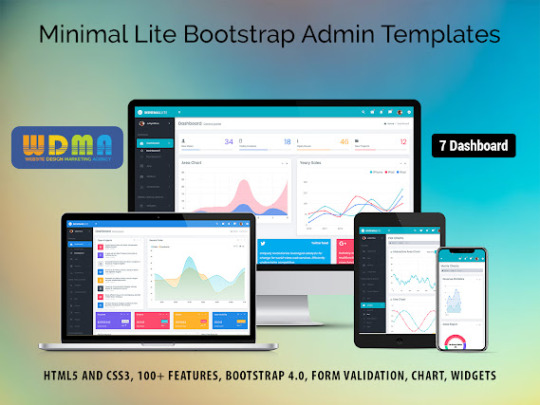
Minimal Lite – Responsive Web Application Kit boasts an extensive array of functionalities, including mobile responsiveness, flexible colour palettes, data presentation utilities, and intuitive interfaces. This Responsive Web Application Kit seamlessly integrates with numerous plugins and add-ons, enriching the administrative dashboard's capabilities. Minimal Lite comes complete with pre-built components, widgets, and styling alternatives, streamlining the development journey. Leveraging the Latest Bootstrap Beta Framework, alongside cutting-edge technologies HTML5 and CSS3, this Premium Admin Template ensures agility and adaptability. Lightweight and highly adaptable, it caters specifically to developers seeking customization options. For inquiries and acquisition of our sophisticated Bootstrap Admin Template.
#Responsive Web Application Kit#Responsive Admin Dashboard Template#Premium Admin Template#Bootstrap Admin Web App#Admin Dashboard Ui Kit#Dashboard Design#Admin Panel Dashboard#Admin Theme#WebApp Template#Dashboard UI Kit
0 notes
Text
Mplify - Versatile Bootstrap 4 Admin Template by Thememakker
Mplify Admin makes the development process easy and fast for you and aims to help you implement your idea in real time.
Product Highlights
Mplify is a fully professional, responsive, modern, multi-purpose, and feature-rich admin template. It can be used to create various websites, admin templates, admin dashboards, backend websites, CMS, CRM, blogs, business websites, timelines, and portfolios. This versatility makes it an ideal choice for developers looking to build functional and aesthetically pleasing web applications efficiently.
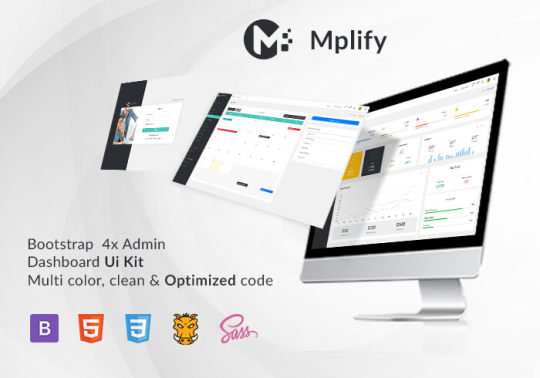
Key Features
Bootstrap 4.3.1: Ensures compatibility and modern design standards.
jQuery 3.3.1: Offers extensive plugins and support.
Built-in SCSS: Provides more flexibility and control over styles.
Light & Dark Full Support: Allows users to switch between light and dark themes.
RTL Full Support: Right-to-left language support for global accessibility.
W3C Validate Code: Ensures high coding standards and practices.
Mobile and Tablet Friendly: Responsive design for all devices.
Treeview: For hierarchical data display.
Drag & Drop Upload: Simplifies file uploading processes.
Image Cropping: Integrated tools for editing images.
Summernote: Rich text editor integration.
Markdown: Support for markdown formatting.
Beautiful Inbox Interface: User-friendly email management.
User-Friendly Chat App: Built-in chat application.
Scrum & Kanban Taskboard: Task management tools.
Add Events to Your Calendar: Event management capabilities.
File Manager: Efficient file organization and management.
Blogging: Tools to manage and create blog posts.
Testimonials: Features to showcase user testimonials.
Maintenance: Tools to manage and schedule maintenance.
Team Board: Collaboration tools for team management.
Search Result: Enhanced search functionalities.
Beautiful Pricing: Elegant pricing tables and plans.
Contact List & Grid: Efficient contact management.
User Profile: Customizable user profiles.
Extended Forms: Advanced form functionalities.
Clean Widgets: A variety of clean, modern widgets.
Technical Specifications
Bootstrap 4.3.1
Bootstrap 4.3.1 is a powerful front-end framework for faster and easier web development. It includes HTML and CSS-based design templates for typography, forms, buttons, tables, navigation, modals, image carousels, and many other interface components, as well as optional JavaScript plugins. Mplify leverages Bootstrap 4.3.1 to ensure a consistent and responsive design across all devices.
jQuery 3.3.1
jQuery is a fast, small, and feature-rich JavaScript library. It makes things like HTML document traversal and manipulation, event handling, and animation much simpler with an easy-to-use custom API integration that works across a multitude of browsers. Mplify includes jQuery 3.3.1 to provide enhanced functionality and interactivity to your applications.
Built-in SCSS
SCSS is a preprocessor scripting language that is interpreted or compiled into CSS. It allows you to use variables, nested rules, mixins, inline imports, and more, all with a fully CSS-compatible syntax. With SCSS, Mplify offers a more powerful and flexible way to manage styles.
Light & Dark Full Support
Mplify comes with built-in support for light and dark themes, allowing users to switch between these modes based on their preferences. This feature enhances user experience and accessibility, especially in different lighting conditions.
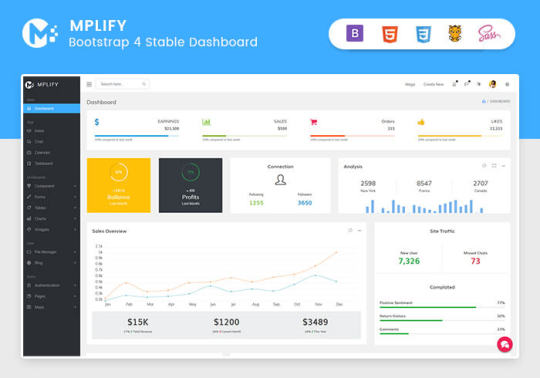
RTL Full Support
For developers targeting global audiences, Mplify provides full right-to-left (RTL) language support. This feature ensures that languages like Arabic, Hebrew, and Persian are properly displayed, making the template versatile and inclusive.
W3C Validate Code
The World Wide Web Consortium (W3C) sets the standards for web development. Mplify adheres to W3C's coding standards, ensuring that the template is built with clean, valid code, which improves browser compatibility, SEO, and overall performance.
Mobile and Tablet Friendly
In today's mobile-first world, having a responsive design is crucial. Mplify is designed to be fully responsive, ensuring that your mobile application looks great and functions seamlessly on all devices, including desktops, tablets, and smartphones.
Applications
Mplify’s versatile design and feature set make it suitable for a wide range of applications across various industries. Here are some key applications:
Admin Dashboards
Mplify provides a robust framework for building admin dashboards. With its extensive set of UI components, charts, forms, and tables, you can create comprehensive dashboards that provide valuable insights and data visualization.
CMS (Content Management Systems)
With features like blogging, file management, and user profile management, Mplify can be used to build powerful CMS platforms. Its clean widgets and beautiful interface ensure that the content management experience is both efficient and enjoyable.
CRM (Customer Relationship Management)
Mplify’s built-in tools for managing contacts, scheduling events, and maintaining communication through a chat app make it an excellent choice for developing CRM systems. These features help businesses manage customer interactions and data effectively.
Business Websites
The multi-purpose nature of Mplify allows it to be used for various business websites. Whether you need a portfolio, a blog, or a corporate website, Mplify provides the necessary tools and components to create a professional online presence.
Blogging Platforms
With integrated tools like Summernote for rich text editing and Markdown support, Mplify is ideal for creating blogging platforms. The beautiful inbox interface and testimonial features enhance the blogging experience, making it easy to manage and publish content.
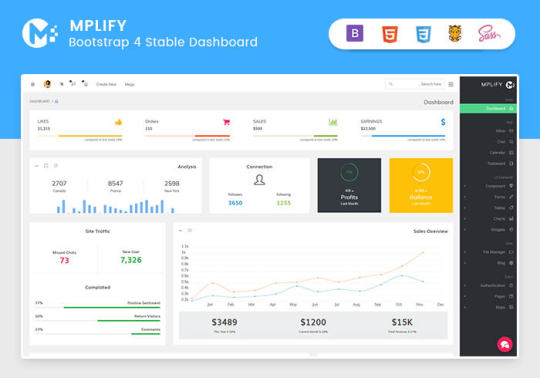
Benefits
Easy and Fast Development
Mplify is designed to streamline the development process. With its pre-built components and templates, you can quickly assemble functional and aesthetically pleasing applications. This reduces development time and costs, allowing you to focus on implementing your ideas in real time.
Professional and Modern Design
Mplify offers a clean, modern design that is both professional and user-friendly. The template includes a variety of customizable widgets and components that adhere to the latest design standards, ensuring your application looks polished and up-to-date.
Comprehensive Feature Set
From task management tools like Scrum and Kanban boards to extensive form functionalities, Mplify provides a wide range of features that cater to various needs. This comprehensive feature set makes it a versatile solution for different types of projects.
Responsive and Mobile-Friendly
With Mplify, you can ensure that your application is accessible on all devices. Its responsive design adapts to different screen sizes, providing a seamless user experience on desktops, tablets, and smartphones.
Global Accessibility
Mplify’s RTL support and multi-language capabilities make it suitable for global applications. This feature ensures that your application can cater to users from different regions, enhancing its reach and usability.
Regular Updates and Support
When you purchase a license for Mplify, you receive all future updates for free. This ensures that your application remains up-to-date with the latest features and improvements. Additionally, Mplify provides excellent customer support to assist with any issues or queries.
Challenges and Limitations
Learning Curve
While Mplify is designed to be user-friendly, there may be a learning curve for beginners who are not familiar with Bootstrap or jQuery. However, comprehensive documentation and community support can help mitigate this challenge.
Customization
Although Mplify offers a wide range of customization options, extensive customization may require advanced knowledge of SCSS and JavaScript. This could be a limitation for developers who are not well-versed in these technologies.
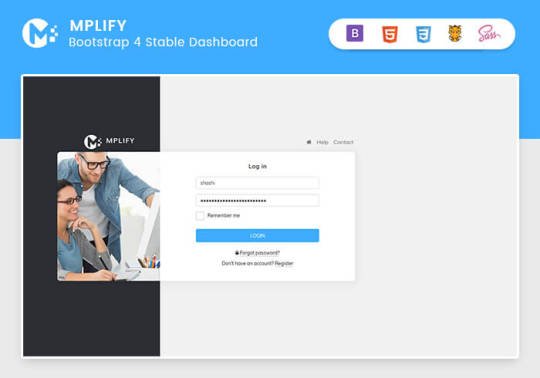
Performance
As with any feature-rich template, there is a potential for performance issues if too many components and plugins are used simultaneously. It is important to optimize the application and selectively use features to maintain optimal performance.
Latest Innovations
Enhanced UI Components
Mplify continues to evolve with regular updates that introduce new and improved UI components. These enhancements ensure that your application remains modern and functional.
Advanced-Data Visualization
Recent updates have focused on improving data visualization capabilities. With enhanced charting tools and interactive elements, Mplify allows for more dynamic and engaging data presentation.
Integration with New Technologies
Mplify is continuously updated to integrate with the latest web technologies. This ensures compatibility with new frameworks and libraries, providing developers with more tools to build advanced applications.
Future Prospects
AI and Machine Learning Integration
The future of Mplify may include integration with AI and machine learning tools. This would enable developers to build more intelligent and automated applications, enhancing user experience and functionality.
Expanded Plugin Support
As the web development landscape evolves, Mplify is likely to expand its plugin support. This will provide developers with more options for extending the functionality of their applications.
Improved Accessibility Features
Mplify is expected to continue enhancing its accessibility features. This includes better support for assistive technologies and compliance with accessibility standards, ensuring that applications built with Mplify are inclusive for all users.
Comparative Analysis
Versus Other Bootstrap Templates
When compared to other Bootstrap templates, Mplify stands out due to its comprehensive feature set, modern design, and extensive customization options. While other templates may offer similar components, Mplify's unique features like RTL support and advanced task management tools give it an edge.
Versus Custom Development
Opting for a pre-built template like Mplify can significantly reduce development time and costs compared to custom web development. While custom development offers more flexibility, Mplify provides a robust foundation that can be easily customized to meet specific needs.
User Guides and Tutorials
Getting Started with Mplify
Installation: Download and install Mplify from the official website or marketplace.
Configuration: Configure the template settings according to your project requirements.
Customization: Use the built-in SCSS files to customize the styles and appearance.
Integration: Integrate Mplify with your backend systems and databases.
Deployment: Deploy your application on your preferred hosting platform.
Advanced Customization Techniques
SCSS Variables: Use SCSS variables to easily change colors, fonts, and other styles.
JavaScript Customization: Extend the functionality by adding custom JavaScript code.
Component Modification: Modify existing components or create new ones to meet specific needs.
Performance Optimization: Optimize the performance by minifying CSS and JavaScript files, and selectively loading components.
Conclusion
Mplify is a powerful, versatile, and user-friendly Bootstrap 4 admin dashboard template. It offers a wide range of features and customization options, making it suitable for various applications, from admin dashboards to business websites. With its modern design, responsive layout, and extensive documentation, Mplify simplifies the development process, allowing developers to implement their ideas in real time efficiently.
Whether you are building a CMS, CRM, or a personal blog, Mplify provides the tools and flexibility needed to create a professional and functional web application. Its ongoing updates and support ensure that your projects remain current and compatible with the latest web technologies.
#Mplify Admin#Bootstrap 4.3.1#jQuery 3.3.1#SCSS#Light & Dark Theme#RTL Support#W3C Validation#Responsive Design#Admin Template#Admin Dashboard#CMS#CRM#Blogging#Business Websites#Web Development#UI Components#Data Visualization#AI Integration#Machine Learning#Accessibility Features#Task Management#File Management#Rich Text Editor#Markdown Support#User Profiles#Performance Optimization#Web Technologies#Custom Development#Web Application Development#Front-end Framework
0 notes
Text
What is React and React Native? Understanding the Difference
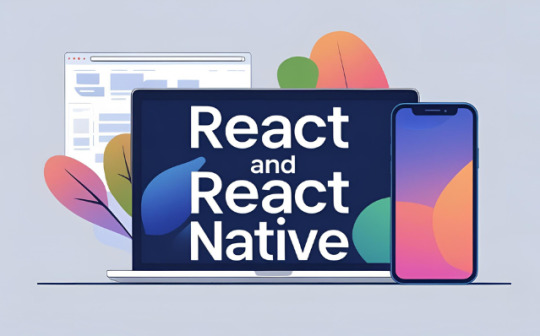
If you're starting out in frontend or mobile development, you've likely heard of both React and React Native. But what exactly are they, and how do they differ?
In this guide, we’ll break down what is React and React Native, their use cases, key differences, and when you should use one over the other.
What is React?
React (also known as React.js or ReactJS) is an open-source JavaScript library developed by Facebook, used to build user interfaces—primarily for single-page applications (SPAs). It's component-based, efficient, and declarative, making it ideal for building dynamic web applications.
Key Features of React:
Component-based architecture: Reusable pieces of UI logic.
Virtual DOM: Improves performance by reducing direct manipulation of the real DOM.
Unidirectional data flow: Predictable state management.
Rich ecosystem: Integrates well with Redux, React Router, and Next.js.
Common Use Cases:
Building dynamic web apps and dashboards
Single-page applications (SPAs)
E-commerce platforms
Admin panels and content management systems
What is React Native?
React Native is also developed by Facebook but is used for building native mobile apps using React principles. It enables developers to write apps using JavaScript and React, but renders UI components using native APIs—meaning it works just like a real native app.
Key Features of React Native:
Cross-platform compatibility: Build apps for both iOS and Android with a single codebase.
Native performance: Uses real mobile components.
Hot reloading: Faster development cycles.
Community support: Large ecosystem of plugins and libraries.
Common Use Cases:
Mobile apps for startups and MVPs
Apps with simple navigation and native look-and-feel
Projects that need rapid deployment across platforms
React vs React Native: Key Differences
Feature
React (React.js)
React Native
Platform
Web browsers
iOS and Android mobile devices
Rendering
HTML via the DOM
Native UI components
Styling
CSS and preprocessors
Uses StyleSheet API (like CSS in JS)
Navigation
React Router
React Navigation or native modules
Ecosystem
Rich support for web tools
Tailored to mobile development
Performance
Optimized for web
Optimized for native mobile experience
When to Use React
Choose React when:
You're building a web application or website
You need SEO optimization (e.g., with Next.js)
Your app depends heavily on web-based libraries or analytics tools
You want precise control over responsive design using HTML and CSS
When to Use React Native
Choose React Native when:
You need a mobile app for both iOS and Android
Your team is familiar with JavaScript and React
You want to reuse logic between mobile and web apps
You’re building an MVP to quickly test product-market fit
Can You Use Both Together?
Yes! You can share business logic, APIs, and sometimes even components (with frameworks like React Native Web) between your React and React Native projects. This is common in companies aiming for a unified development experience across platforms.
Real-World Examples
React is used in web apps like Facebook, Instagram (web), Airbnb, and Netflix.
React Native powers mobile apps like Facebook, Instagram (mobile), Shopify, Discord, and Bloomberg.
Final Thoughts
Understanding what is React and React Native is essential for any frontend or full-stack developer. React is perfect for building fast, scalable web applications, while React Native enables you to build cross-platform mobile apps with a native experience. If you’re deciding between the two, consider your target platform, performance needs, and development resources. In many modern development teams, using both React and React Native allows for a consistent developer experience and code reuse across web and mobile platforms.
2 notes
·
View notes
Text
What Makes DigiCovai the Best eCommerce Development Company in Coimbatore?

Creating a website is not simply a choice in today's digitally-first economy; it is a need for businesses. One thing is certain, regardless of whether you are a manufacturer in Kurichi, a wholesaler in Peelamedu, or a tiny retailer in Town Hall: your consumers are online, and your store should be as well. But picking the perfect companion to guide you there? This is where DigiCovai is useful.
Here are some of the reasons why companies from a variety of sectors regard DigiCovai as the top E - Commerce Development Company in Coimbatore and why they depend on our team to take their brand online.
Built for Sales, Not Just Looks
At DigiCovai, we think your website should do more than just be "live." For this reason, we do more than just design attractive storefronts. We create unique eCommerce websites with backend systems that grow with your company, are optimized for mobile browsing, and are built to convert. Every click, from cart abandonment recovery to product filtering, is designed to have an impact.
24/7 Sales with Web + Mobile
Given that 70% of consumers explore or make purchases on their phones, your online business has to be as responsive as it is on desktops. Our eCommerce solutions are completely mobile-friendly, and for organizations hoping to cultivate enduring client loyalty, iOS and Android app development is a possibility. Since you can own a place in your customers' wallets, why stop at a website?
Methodology-First Method
We listen before we code anything. Every project starts with a strategy meeting to learn about your product, target market, and corporate objectives. After that, we create a user experience that is specific to your target market, regardless of how many goods you sell five or five thousand.
Customized Solutions for All Sectors
Every company is different, and your online store should be no exception. DigiCovai is a Coimbatore-based full-service eCommerce development business that provides tailored solutions for retail stores and boutiques.
Manufacturers Selling Straight to Customers
Delivery of Essentials & Grocery
Skin Care & Cosmetics Brands
Accessories & Electronics
Marketplaces with many vendors
eCommerce Partner All-in-One
DigiCovai is your digital growth team, not just a development company. Everything you need to create, expand, and develop your online store without worry is provided by us, from UI/UX design and secure payment gateway integration to real-time analytics dashboards and post-launch maintenance.
Findings That Make an Order
Mobile apps have improved retention, streamlined backend operations with bespoke admin panels, and increased traffic by up to three times for our clients. What's the best part? They only needed to be prepared to expand; they didn't need to be tech-savvy.
Final Thought
Many developers are available to "build you a website." However, DigiCovai is your partner if you're searching for an E - Commerce Development Company in Coimbatore that creates for outcomes, dependability, and long-term growth.
Together, let's create your 24/7 store.
youtube
2 notes
·
View notes
Text
Fantasy Cricket App Development: Build the Ultimate App Before the Upcoming Cricket Series 2025
The buzz around fantasy cricket app development is louder than ever as cricket fans across the globe prepare for the upcoming cricket series in 2025, including the India vs Australia bilateral series, Asia Cup 2025, and the much-anticipated T20 World Cup 2025. With millions of users participating in online fantasy leagues, developing a fantasy cricket app is not just a trend—it's a smart business move.
Whether you're a startup, sports enthusiast, or entrepreneur looking to tap into the lucrative world of fantasy sports, now is the ideal time to invest in a fantasy cricket app tailored for the upcoming tournaments.
What is Fantasy Cricket App Development?
Fantasy cricket app development involves creating a digital platform (mobile or web-based) where users form their own virtual cricket teams from real-life players and score points based on players' actual performances in live matches. The better their selected players perform, the more points users earn and the higher their chances of winning real rewards.
A fantasy cricket app should offer a seamless and engaging user experience, real-time data, secure transactions, and features that align with the user intent of cricket lovers: real-time gameplay, rewards, excitement, and community engagement.
Why Fantasy Cricket App Development is Booming in 2025
With upcoming cricket events like the Asia Cup 2025, T20 World Cup 2025, IPL 2025, and India vs Australia series, the fantasy sports industry is set to see a record-breaking number of users. Here’s why this is the perfect time to launch your app:
📈 Rapid User Growth: India alone has over 150 million fantasy sports users.
🏏 High Cricket Engagement: Users spend hours analyzing and picking teams.
💡 Advanced Tech Options: APIs, AI-powered analytics, and real-time updates are easily available.
💰 Profit-Driven Model: Revenue from entry fees, ads, and in-app purchases.
🔐 Secure Legal Framework: Fantasy sports are legally allowed as games of skill in India and many other countries.
Key Features of a High-Performance Fantasy Cricket App
To compete with the big names like Dream11, My11Circle, and MPL, your fantasy cricket app must include:
✅ User Panel Features:
Quick registration/login via email or mobile
Real-time match stats and score updates
User-friendly interface and leaderboard
Multiple contest types (free, paid, private)
Instant wallet integration (deposit/withdrawal)
🛠️ Admin Panel Features:
Manage users, contests, payments, and referrals
Monitor player performance and scoring systems
Handle complaints and support tickets
Push notifications and analytics dashboard
Fantasy Cricket App Development Cost in 2025
The fantasy cricket app development cost varies based on complexity, features, and design. Here's a rough breakdown:
Basic App (Android/iOS): ₹3,00,000 – ₹6,00,000
Mid-level App (Custom UI/UX + Real-time Stats): ₹6,00,000 – ₹10,00,000
Advanced App (Multi-sport, AI, Global Support): ₹10,00,000 – ₹20,00,000+
Working with a professional fantasy sports app development company like IMG Global Infotech ensures a secure, fast, and feature-rich application.
Monetization Strategies for Fantasy Cricket Apps
Wondering how to make money from a fantasy cricket app? These proven methods drive revenue:
💸 Entry Fees for Paid Contests
📊 In-app Advertisements (Google AdMob, Facebook Ads)
🏷️ Premium Memberships
🤝 Sponsorships and Brand Collaborations
📈 Affiliate Marketing and Referrals
Best Technology Stack for Fantasy App Development
To develop a robust, scalable fantasy app, you need a modern and reliable tech stack:
Frontend: React Native, Flutter (for cross-platform)
Backend: Node.js, Laravel, Python (for fast performance)
Database: MongoDB, PostgreSQL
APIs: Cricket Score API (CricAPI, SportsRadar), Payment Gateway (Razorpay, Paytm)
Why Choose IMG Global Infotech for Fantasy Cricket App Development?
IMG Global Infotech is one of the most trusted names in fantasy cricket app development in India, offering customized and scalable fantasy sports solutions. Whether you're building an app like Dream11 or want a unique concept, they deliver:
✅ Seamless user experience
✅ Real-time data sync
✅ Custom contests and AI-based recommendations
✅ Secure wallet system
✅ Post-launch technical support
Their experience in delivering high-performance fantasy cricket apps makes them the preferred choice for entrepreneurs and startups in the fantasy gaming space.
Semantic SEO & Conversational Keywords to Use
When optimizing your site or app page, include the following semantic SEO keywords to improve visibility and ranking:
fantasy cricket app development company
best fantasy cricket app developers
build a fantasy cricket app like Dream11
fantasy sports app solutions India
cost to develop fantasy cricket app
create fantasy app for IPL 2025
fantasy sports app development guide
These keywords match what users are actively searching for in 2025 and help improve topical relevance and search intent targeting.
FAQs – Fantasy Cricket App Development 2025
Q1. Can I create a fantasy cricket app before IPL or T20 World Cup 2025? Yes, this is the ideal time to launch your app before the upcoming cricket events. It ensures maximum user engagement.
Q2. Is fantasy cricket legal in India? Yes, fantasy cricket is considered a game of skill and is legal in most Indian states.
Q3. What is the revenue model of fantasy cricket apps? Fantasy apps earn via contest entry fees, ads, premium plans, and brand sponsorships.
Q4. How long does it take to develop a fantasy cricket app? Basic apps take 2–3 months, while advanced platforms may take 4–6 months depending on features.
Q5. Which company is best for fantasy cricket app development? IMG Global Infotech is highly recommended for fantasy cricket app development with a strong portfolio and custom features.
Final Thoughts
With the T20 World Cup 2025, IPL 2025, and Asia Cup on the horizon, there's never been a better time to invest in fantasy cricket app development. By partnering with expert developers like IMG Global Infotech, you can launch a feature-rich, profitable app that captures the excitement of cricket and turns fans into daily users.
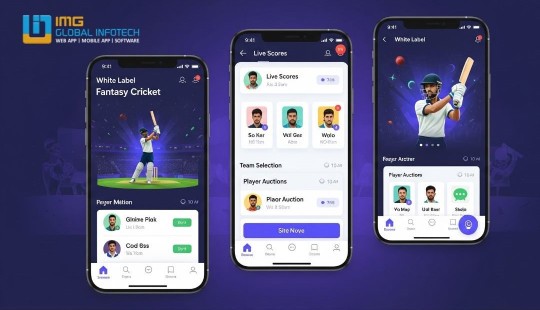
#fantasy cricket app development#fantasy cricket app development company#fantasy cricket app development company in india#fantasy cricket app development cost#fantasy cricket app#app like dream11#img global infotech
1 note
·
View note
Text
#Playstation7 #framework #BasicArchitecture #RawCode #RawScript #Opensource #DigitalConsole
To build a new gaming console’s digital framework from the ground up, you would need to integrate several programming languages and technologies to manage different aspects of the system. Below is an outline of the code and language choices required for various parts of the framework, focusing on languages like C++, Python, JavaScript, CSS, MySQL, and Perl for different functionalities.
1. System Architecture Design (Low-level)
• Language: C/C++, Assembly
• Purpose: To program the low-level system components such as CPU, GPU, and memory management.
• Example Code (C++) – Low-Level Hardware Interaction:
#include <iostream>
int main() {
// Initialize hardware (simplified example)
std::cout << "Initializing CPU...\n";
// Set up memory management
std::cout << "Allocating memory for GPU...\n";
// Example: Allocating memory for gaming graphics
int* graphicsMemory = new int[1024]; // Allocate 1KB for demo purposes
std::cout << "Memory allocated for GPU graphics rendering.\n";
// Simulate starting the game engine
std::cout << "Starting game engine...\n";
delete[] graphicsMemory; // Clean up
return 0;
}
2. Operating System Development
• Languages: C, C++, Python (for utilities)
• Purpose: Developing the kernel and OS for hardware abstraction and user-space processes.
• Kernel Code Example (C) – Implementing a simple syscall:
#include <stdio.h>
#include <unistd.h>
int main() {
// Example of invoking a custom system call
syscall(0); // System call 0 - usually reserved for read in UNIX-like systems
printf("System call executed\n");
return 0;
}
3. Software Development Kit (SDK)
• Languages: C++, Python (for tooling), Vulkan or DirectX (for graphics APIs)
• Purpose: Provide libraries and tools for developers to create games.
• Example SDK Code (Vulkan API with C++):
#include <vulkan/vulkan.h>
VkInstance instance;
void initVulkan() {
VkApplicationInfo appInfo = {};
appInfo.sType = VK_STRUCTURE_TYPE_APPLICATION_INFO;
appInfo.pApplicationName = "GameApp";
appInfo.applicationVersion = VK_MAKE_VERSION(1, 0, 0);
appInfo.pEngineName = "GameEngine";
appInfo.engineVersion = VK_MAKE_VERSION(1, 0, 0);
appInfo.apiVersion = VK_API_VERSION_1_0;
VkInstanceCreateInfo createInfo = {};
createInfo.sType = VK_STRUCTURE_TYPE_INSTANCE_CREATE_INFO;
createInfo.pApplicationInfo = &appInfo;
vkCreateInstance(&createInfo, nullptr, &instance);
std::cout << "Vulkan SDK Initialized\n";
}
4. User Interface (UI) Development
• Languages: JavaScript, HTML, CSS (for UI), Python (backend)
• Purpose: Front-end interface design for the user experience and dashboard.
• Example UI Code (HTML/CSS/JavaScript):
<!DOCTYPE html>
<html>
<head>
<title>Console Dashboard</title>
<style>
body { font-family: Arial, sans-serif; background-color: #282c34; color: white; }
.menu { display: flex; justify-content: center; margin-top: 50px; }
.menu button { padding: 15px 30px; margin: 10px; background-color: #61dafb; border: none; cursor: pointer; }
</style>
</head>
<body>
<div class="menu">
<button onclick="startGame()">Start Game</button>
<button onclick="openStore()">Store</button>
</div>
<script>
function startGame() {
alert("Starting Game...");
}
function openStore() {
alert("Opening Store...");
}
</script>
</body>
</html>
5. Digital Store Integration
• Languages: Python (backend), MySQL (database), JavaScript (frontend)
• Purpose: A backend system for purchasing and managing digital game licenses.
• Example Backend Code (Python with MySQL):
import mysql.connector
def connect_db():
db = mysql.connector.connect(
host="localhost",
user="admin",
password="password",
database="game_store"
)
return db
def fetch_games():
db = connect_db()
cursor = db.cursor()
cursor.execute("SELECT * FROM games")
games = cursor.fetchall()
for game in games:
print(f"Game ID: {game[0]}, Name: {game[1]}, Price: {game[2]}")
db.close()
fetch_games()
6. Security Framework Implementation
• Languages: C++, Python, Perl (for system scripts)
• Purpose: Ensure data integrity, authentication, and encryption.
• Example Code (Python – Encrypting User Data):
from cryptography.fernet import Fernet
# Generate a key for encryption
key = Fernet.generate_key()
cipher_suite = Fernet(key)
# Encrypt sensitive user information (e.g., account password)
password = b"SuperSecretPassword"
encrypted_password = cipher_suite.encrypt(password)
print(f"Encrypted Password: {encrypted_password}")
# Decrypting the password
decrypted_password = cipher_suite.decrypt(encrypted_password)
print(f"Decrypted Password: {decrypted_password}")
7. Testing and Quality Assurance
• Languages: Python (for automated tests), Jest (for JavaScript testing)
• Purpose: Unit testing, integration testing, and debugging.
• Example Unit Test (Python using unittest):
import unittest
def add(a, b):
return a + b
class TestGameFramework(unittest.TestCase):
def test_add(self):
self.assertEqual(add(10, 20), 30)
if __name__ == '__main__':
unittest.main()
8. Order of Implementation
• Phase 1: Focus on core system architecture (low-level C/C++) and OS development.
• Phase 2: Develop SDK and start building the basic framework for UI and input management.
• Phase 3: Work on backend systems like the digital store and integrate with front-end UI.
• Phase 4: Begin rigorous testing and debugging using automated test suites.
This comprehensive approach gives you a detailed idea of how each component can be built using a combination of these languages and technologies. Each section is modular, allowing teams to work on different aspects of the console simultaneously.
[Pixel Art/Sprites/Buildinodels/VictoriaSecretPixelArtKit #Playstation7 #DearDearestBrands]

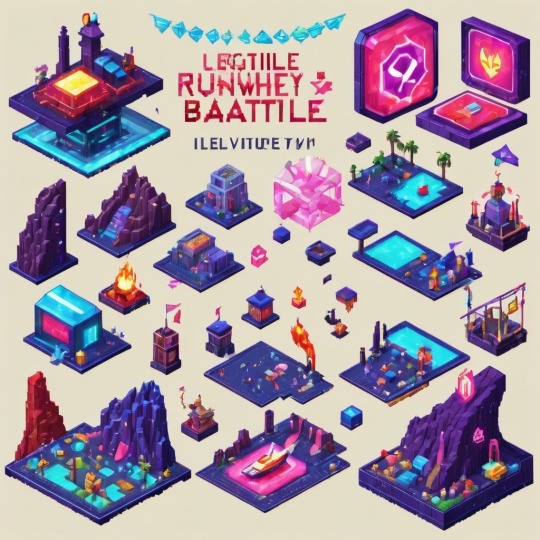
#victoriasecretrunway#runwaybattle#victoria secret fashion#victoria secert model#victoriasecret#victoria secret#VictoriaSecretRunwayBattle#capcom victoriasecret#capcom videogames#playstation7#ps7#deardearestbrands#capcom#digitalconsole#python#script#rawscript#raw code#framework#VictoriaSecretVideoGame#deardearestbrandswordpress
2 notes
·
View notes
Text

Finance Fintech Admin Dashboard UI Design
2 notes
·
View notes
Text
Empower Your Web Development with Premium Admin Template : Aries Admin
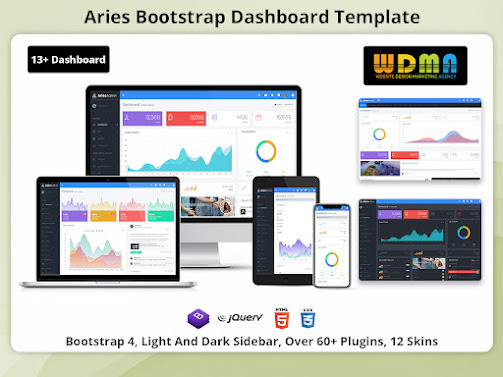
Introducing the Aries Premium Admin Template – meticulously engineered to cater to the dynamic needs of admin panels and dashboards. Featuring an extensive array of functionalities, our Responsive Web Application Kit boasts over 13 diverse dashboards tailored to empower your E-commerce operations. Today, our spotlight shines on the E-commerce dashboard, a powerhouse of data visualization. At its core lies the campaign chart, offering a comprehensive overview of impressions, top performers, conversions, and CPA metrics. This Responsive Admin Dashboard Template dashboard encapsulates vital insights ranging from new client acquisitions to product launches and invoicing activities. Seamlessly integrated modules like 'My New Clients,' 'New Products,' and 'New Invoices' provide real-time updates, ensuring you stay ahead of the curve.Beyond its E-commerce prowess, our admin template presents a plethora of features designed to streamline your workflow. Dive into the world of applications, leverage intuitive mailbox functionalities, and explore an extensive library of UI elements. With customisable widgets at your disposal, including dynamic blog widgets, charts, tables, and email templates, your possibilities are boundless. Furthermore, harness the power of maps and extensions to enhance user experience and extend functionality. Crafted with developers in mind, our combines versatility with ease of integration, enabling you to build robust solutions effortlessly.Experience the epitome of modern admin management with the Aries Admin Dashboard UI Kit – where innovation meets efficiency.
#Responsive WebApplication Kit#Responsive Admin Dashboard Template#Premium Admin Template#Bootstrap Admin Web App#Admin Dashboard Ui Kit
0 notes
Text
ALUI Developed by Thememakker - Bootstrap-Powered, Best-Ever Dashboard Template
In the fast-paced world of web development, having the right tools at your disposal can make all the difference. Thememakker, a leading web design company, brings you ALUI - an admin dashboard template that's set to revolutionize your web development projects. In this article, we'll delve into what makes ALUI a standout choice for developers.
Bootstrap Powered Excellence
ALUI powered by Bootstrap, the industry-standard framework that provides a solid foundation for web development. With Bootstrap, you can expect clean, responsive, and mobile-friendly designs, ensuring your website looks great on any device. Thememakker has taken Bootstrap and elevated it to the next level with ALUI, making it the ideal choice for any company's needs.
A Simple Three-Step Process
ALUI helps you streamline your web development process by following a straightforward, three-step process:
Download Template
First, ensure that your license aligns with your project requirements. Download the latest version of the ALUI template from Themeforest, and you're ready to kickstart your project.
Choose Template
Browse through a multitude of templates tailored for various technologies and business niches. ALUI offers a wide variety of options to cater to your specific needs.
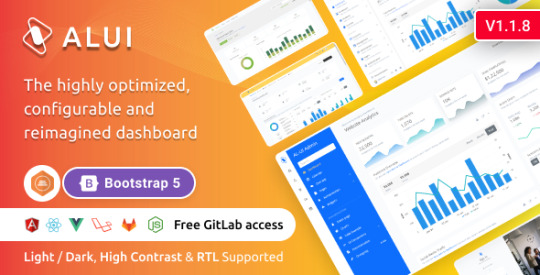
Ready to Work
You can set up a starter kit for your preferred technology or select an HTML template that suits your project requirements. ALUI ensures you have the flexibility to choose what works best for you.
Discover ALUI's Features and functionalities
ALUI is feature-rich and comes with seamless technology integration and a range of benefits, including:
Powerful Dashboard Widgets
ALUI boasts incredibly powerful dashboard widgets developed by experienced professional designers. These widgets are designed with a standardized structure to future-proof your projects.
A few lines of code are all it takes to invoke these dynamic widgets, which support various technologies and breathe life into your dashboard.
Highly Standardized UI/UX with an Easy-to-Use Interface
ALUI's highly standardized styles come with centralized elements and widgets, making it a breeze to use these elements in your projects. Whether you're working on a Hospital UI or a HR-Project management widget, ALUI's design architecture ensures versatility.
Uniquely Handcrafted Layouts
ALUI offers over 20 handcrafted layouts created by passionate web designers at Thememakker. These layouts are designed to make your project visually stunning and highly functional.
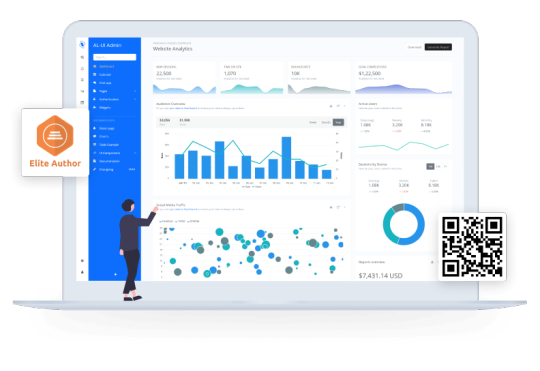
Planned Smart Updates
ALUI keeps your project up to date effortlessly. By replacing styles without requiring any coding or structural changes, ALUI ensures your project remains current. Major updates are designed to affect the core structure minimally, making the process smooth and hassle-free.
Centralized Widget Library
ALUI provides access to a centralized widget library that houses styles for creating widgets from various niches. This means you can take widgets from different niches and use them in your project, transforming it into a multi-domain platform.
Seamlessly Integrated Layouts
Uniquely designed layouts of ALUI look stunning and are logically integrated into different platforms. Whether you're using Angular, ReactJS, Laravel, HTML, VueJS, or VueJS + Laravel, ALUI makes it easy to update routes and elements in your menus.
High Contrast Theme for Better Accessibility
ALUI features a pre-built high-contrast theme that enhances accessibility. When you adhere to ALUI's standards, this theme is automatically applied to all elements, including charts and labels.
10 Reasons to Choose ALUI Admin Dashboard Developed by Thememakker
Developer-Friendly: ALUI is built on the Bootstrap 5 Design Framework, making it easy for team members to understand and integrate niche components.
Feature-Rich: ALUI offers a broad range of features that can be added to your product, impressing end-users.
Billions of Theming Possibilities: Customize your theme to match your brand using dynamic theme options.
Suitable for All: ALUI is designed for professionals, brands, and countries, offering multiple themes, layouts, business segments, and more.
SUPER Time Saver: ALUI's flexible architecture and prebuilt layouts save you time and effort in theme integration.
Simple Yet Powerful: Create stunning dashboards with ease, making ALUI one of the most productive theme design on the market.
Tons of Pages: With over 5000 pages and a variety of widgets, ALUI caters to a wide range of needs.
Made by Developers, For Developers: Empower developers with a powerful UI Kit, making development more efficient.
Easy to Customize: Once you understand ALUI's architecture, customization is a breeze, allowing you to design new widgets and dashboards with dynamic theme options.
Lifetime Updates: ALUI offers lifetime updates to stay in line with the latest trends.
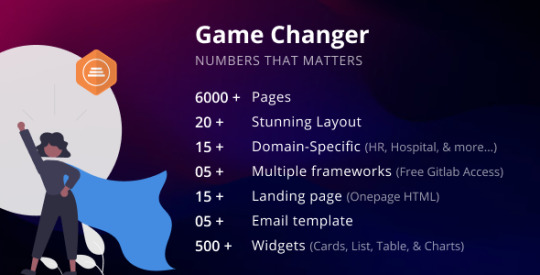
ALUI caters to a variety of technologies, including:
ReactJS: Prebuilt ReactJS dashboard with a starter kit.
Angular: Prebuilt Angular dashboard with a starter kit.
Laravel: Prebuilt Laravel dashboard with a starter kit.
HTML: A set of mighty HTML dashboard templates.
VueJS: Prebuilt VueJS dashboard with a starter kit.
VueJS + Laravel: Prebuilt VueJS + Laravel dashboard with a starter kit.
ASP .NET Core MVC: Prebuilt ASP .NET Core MVC starter kit (Coming soon).
1,000+ Satisfied Users
ALUI's designs have been loved by millions, with positive feedback from clients and users. It's a testament to the excellence of Thememakker's work.
ALUI - A New Standard in Dashboard Design
ALUI is not just an ordinary theme; it's a full library of widgets and layouts designed to take your web development services to the next level. With ALUI, you have the tools and flexibility to create stunning dashboards that meet your unique requirements.
FAQs Clear your all doubts
Do I need to purchase a license for each website?
Yes, you must purchase licenses separately for each of your websites. An extended license is required for commercial sites.
What is a regular license?
A regular license is suitable for end products that do not charge users for access or service. It can be used for a single end product.
What is an extended license?
An extended license is necessary for end products (web services or SAAS) that charge users for access or service. It can also be used for a single-end product.
Which license is applicable for SASS applications?
If you are charging users for using your SASS-based application, you must purchase an extended license for each product. A regular license is suitable when users access your service for free.
What are the lifetime updates for ALUI?
Lifetime updates are offered for all ALUI frameworks and libraries to keep them up to date with the latest trends, ensuring your projects remain current and competitive.
youtube
#ALUI Admin Dashboard#Thememakker#Web Development#Dashboard Template#Bootstrap-Powered#Developer-Friendly#Web Design#Feature-Rich Dashboard#Theming Options#Lifetime Updates#Web Development Tools#Bootstrap Framework#Layouts and Widgets#UI/UX Design#Developer Support#Dynamic Theme Options#Web Development Efficiency#Web Development Projects#User-Friendly Dashboard#Web Development Benefits#Web Development Revolution#Thememakker's ALUI#Responsive Design#Web Development Excellence#Widget Library#Web Development Flexibility#Hand-Crafted Layouts#High Contrast Theme#Smart Updates#Bootstrap Integration
0 notes
Text
IDO Development 2025: Building a Multi‑Chain Launchpad for Ethereum, BSC, Solana & Polygon
Initial DEX Offerings (IDOs) have evolved into one of the most effective methods for blockchain projects to raise capital, build communities, and launch their native tokens. In 2025, the market has matured significantly—ushering in an era where single-chain launchpads are no longer enough. Projects now demand multi-chain compatibility, high throughput, fast onboarding, and rock-solid security. As a result, IDO development has become increasingly complex, requiring precision design, modular infrastructure, and chain-specific customization.

This blog explores how to build a modern, multi-chain IDO launchpad that supports Ethereum, Binance Smart Chain (BSC), Solana, and Polygon. These four chains dominate the decentralized token fundraising landscape and represent a mix of EVM and non-EVM environments. Understanding their unique properties while designing a seamless cross-chain user experience is critical for any development team building in this space.
The Rise of Multi-Chain Fundraising
In 2025, crypto users no longer exist on a single chain. Wallets like MetaMask, Phantom, and OKX now support multi-chain bridging natively, and users demand launchpads that are equally flexible. While Ethereum remains the gold standard for institutional credibility, Solana offers unmatched speed and low fees. Polygon has cemented its position as the go-to layer-2 for consumer apps, and BSC remains an accessible gateway to retail-driven projects.
For IDO developers, this means the backend architecture of a launchpad must support chain-specific smart contracts, liquidity management across DEXs like Uniswap, PancakeSwap, and Raydium, and front-end frameworks that adapt based on wallet and chain detection. Moreover, real-time price feeds, whitelisting databases, KYC workflows, and token vesting mechanics must function independently across all chains—without compromising performance or security.
Core Architectural Considerations
Building a multi-chain IDO launchpad starts with a modular smart contract system that supports extensibility. On Ethereum, BSC, and Polygon, developers can use Solidity to deploy reusable contract templates for fixed-swap pools, staking tiers, token vesting, and liquidity locking. However, Solana requires a fundamentally different approach using Rust and Sealevel’s parallel execution model.
Each chain’s IDO contract should be able to handle the full lifecycle of a public token sale—starting from project listing, KYC whitelisting, staking eligibility checks, allocation caps, payment handling, and eventual token distribution. On the backend, a unified indexer should be designed to track events across all supported chains and normalize them into a central database. This enables cross-chain analytics, admin dashboards, and token claim pages to function without fragmentation.
It’s also important to separate the business logic from UI rendering using APIs that can serve both the investor portal and the project onboarding console. This approach allows faster iteration of front-end features, localization, and mobile support while maintaining stability at the contract layer.
Supporting Chain-Specific Features
Each supported chain introduces technical nuances that directly impact the IDO experience. For example, Ethereum’s high gas fees make batch processing of whitelists expensive, which may push you toward Merkle proofs or off-chain signature verification. BSC, being EVM-compatible, inherits many of Ethereum’s patterns but requires additional protections against bots due to its lower transaction costs.
Solana, on the other hand, offers blazing-fast confirmation times and minimal fees, but developing for it requires a complete shift in thinking. Programs must be optimized for concurrent execution, and on-chain data storage comes with specific rent mechanics. The wallet ecosystem is different too—Phantom and Solflare dominate user adoption, and integrating these wallets requires custom development for UI signatures and transaction flows.
Polygon provides the best of both worlds��EVM compatibility with lower gas fees—making it a preferred choice for consumer-oriented projects. However, it introduces additional infrastructure concerns, such as syncing with their Heimdall and Bor clients and supporting fast finality for bridging and withdrawals.
To deliver a smooth experience, developers must isolate all chain-specific logic at both the smart contract and front-end layers. Abstracting wallet integration, asset bridging, and chain selection ensures that users can navigate seamlessly, whether they’re contributing from Ethereum or claiming tokens on Solana.
Wallet Connectivity and User Authentication
User experience in an IDO begins with wallet connection. In 2025, users expect the launchpad to recognize their wallet provider, auto-detect the correct chain, and display their eligibility status. This demands deep integration with wallet APIs such as MetaMask, WalletConnect, Phantom, and Rabby.
Multi-chain wallet authentication also means tracking wallet addresses across chains and associating them with unique user IDs, especially if KYC is involved. A compliant launchpad must handle identity verification separately for each user while ensuring that the verified identity is portable across chains—without forcing redundant onboarding steps.
Additionally, user dashboards must display relevant staking data, allocation tiers, token balances, and claim statuses—contextually filtered by chain. All of this data should be cached, indexed, and updated in near real-time to prevent delays during high-traffic IDO launches.
Tiered Staking and Allocation Logic
One of the most powerful features of an IDO launchpad is the ability to offer guaranteed allocations to loyal community members through tiered staking systems. These systems reward early supporters and prevent whales from dominating token sales.
To implement this, developers must design smart contracts that lock project-native tokens in staking pools for predefined durations, with multipliers applied based on time, amount, and staking token. Allocation logic can then assign weight scores to each wallet and compute pro-rata access to the IDO pool.
On Ethereum, BSC, and Polygon, this is relatively straightforward using ERC-20 and staking contract templates. On Solana, staking programs must be custom-written and audited separately. Allocation scores must then be relayed to the IDO contract prior to launch, typically using Merkle roots or off-chain proofs.
The tiered staking logic must be transparent, immutable, and integrated with both the investor dashboard and project admin panel. This ensures that allocation disputes are minimized, and participants trust the fairness of the system.
Whitelisting, KYC, and Compliance Workflows
In a regulatory landscape that is becoming more complex, KYC and whitelisting features are now essential in IDO development. Platforms must integrate with third-party identity verification APIs that allow users to complete onboarding in minutes while minimizing data retention on-chain.
Once verified, whitelisted addresses must be registered per IDO. Developers can choose between storing whitelists on-chain (expensive on Ethereum) or using Merkle roots to validate participation rights during contribution. A hybrid model often works best—where identity is verified off-chain, and participation eligibility is confirmed via off-chain signatures stored client-side.
These workflows must be responsive and accessible on all devices. The admin panel for the project team should also offer manual approval tools, export logs, and audit trails to demonstrate compliance in case of regulatory review.
Liquidity Locks, Vesting, and Token Claims
Post-IDO operations are just as critical as the fundraising itself. Investors want to see proof that the project has locked liquidity, delayed token unlocks, and instituted proper safeguards against team dumping. This requires contracts that manage linear or cliff vesting, liquidity locks on DEXs, and delayed claims with transparency.
Liquidity locking contracts must integrate directly with Uniswap on Ethereum, PancakeSwap on BSC, and Raydium on Solana. Vesting contracts should be upgradable but tamper-resistant, with on-chain unlock schedules visible through public dashboards.
Claim portals are the final step for users and must support a wide range of wallet types, network switching, and real-time status updates. These portals need to aggregate data from multiple chains, provide token distribution statuses, and enforce time-based unlock conditions.
To maximize trust, launchpads should offer claim analytics, vesting calendars, and email notifications about upcoming unlocks—bridging the gap between user experience and on-chain transparency.
Smart Contract Security and Auditing
Security remains the cornerstone of IDO development. Every smart contract deployed across chains must undergo rigorous testing, manual review, and third-party auditing. The attack surface is wide—ranging from reentrancy bugs to logic flaws in allocation calculations or vesting schedules.
In 2025, standard practices include formal verification of critical contracts, unit testing with forked mainnet environments, and integration with security scanners like MythX or Slither. Additionally, Solana programs require audit firms proficient in Rust and Solana’s concurrency model, which limits the available pool of trusted vendors.
It is also best practice to publish audit reports publicly, enable bug bounties, and allow time-locked upgrade paths for upgradable proxy contracts. These features build investor confidence and ensure long-term platform integrity.
The Future of Multi-Chain IDO Launchpads
The race for decentralized fundraising dominance is far from over. As new chains emerge and user expectations rise, IDO development must remain agile, secure, and compliant. Multi-chain capabilities are now table stakes—not a competitive edge—and platforms that fail to deliver seamless interoperability will quickly lose relevance.
Whether you’re building an internal launchpad for your ecosystem or creating a public platform for external projects, success in 2025 hinges on your ability to design for scale, security, and user-centricity across Ethereum, BSC, Solana, and Polygon. These are not just chains—they are entry points into distinct crypto cultures, and your platform must speak the language of each.
0 notes
Text
Top White Label Fantasy Sports App Development Company for Quick Launch
The number of people involved in fantasy sports has increased a lot over recent years. As a result of apps like Dream11 and Probo, entrepreneurs are now often creating their own fantasy sports websites. Even so, crafting a safe, scalable, and friendly app from nothing can be both costly and take a lot of time. Here, white-label fantasy sports app development is the answer.
When you want to quickly build a fantasy sports platform, selecting the right partners matters a lot. In this post, we will learn about white label solutions, important features to consider, how much it costs to custom develop a fantasy sports app, and the reasons IMG Global Infotech is the top choice.
What is a white-label fantasy sports app?
A white-label fantasy sports app is a pre-built platform that is customized and rebranded according to your business needs. It allows entrepreneurs to launch their fantasy sports business in a short time without going through the tedious process of building the entire product from scratch. Whether you're interested in fantasy cricket app development, football, kabaddi, or multiple sports, a white label solution can be tailored accordingly.
Why Choose a White Label Solution?
Faster Time to Market Forming a fantasy sports app from scratch usually takes between 6 and 12 months. Working with a white label solution allows you to bring your product to market in just a few weeks.
Cost-Effective Building a fantasy sports app from the ground up is expensive because of the research, design, coding, and testing involved. A white label option can save almost all of these costs.
Tested and Reliable These apps have been used in real life, so they are free from most bugs and work smoothly.
Easy Customization You can upload your logo, pick your colors and add features that match your company branding.
Key Features of a Good Fantasy Sports App
If your intent is to build something general like Dream11 or something specific like Probo, these are the key things every app needs.
User Registration/Login Simple and secure sign-up using email, phone number, or social logins.
User Dashboard A centralized place for users to manage their profile, wallet, matches, and winnings.
Live Match Integration Real-time data updates and scores to keep users engaged.
Multiple Payment Options Seamless integration with payment gateways to deposit and withdraw money.
Leaderboard and Points System Real-time leaderboard updates and transparent points calculation.
Referral System Encourage users to invite friends and earn bonuses.
Admin Panel Complete backend control for match management, user monitoring, and financial analytics.
Fantasy Cricket App Development: A Profitable Niche
Although there are various sports to consider, developing fantasy cricket apps is now the most rewarding for software companies in countries like India. As a result, apps such as Dream11 have grown more popular by luring millions of players during IPL, World Cup, and similar competitions.
If you’re interested in fantasy sports, cricket is the perfect beginning for building your business. Esports sees a huge group of people joining the action, with most remaining engaged during matches.
Cost to Develop a Fantasy Sports App
The cost to develop a fantasy sports app depends on multiple factors:
Type of app (web, Android, iOS, or all)
Custom features
UI/UX design
Backend infrastructure
Third-party API integration (for real-time scores, payment, etc.)
Maintenance and updates
Approximate Cost Breakdown:
White Label Solution: $5,000–$15,000
Custom App Development: $20,000–$80,000+
Time Frame: 3 to 12 weeks for white label, 6 to 12 months for custom development
How to Choose the Best Company?
Selecting the right technology partner can make or break your project. Look for:
Experience in fantasy sports app development
Positive client reviews and case studies
Customization options
Transparent pricing
Post-launch support and maintenance
Choose Best Company: IMG Global Infotech
With white-label fantasy sports apps, IMG Global Infotech proves to be a leading choice among many. Thanks to their many years of building secure and scalable fantasy sports platforms, they provide everything you need to start your own app just like Dream11 or app like Probo.
Why Choose IMG Global Infotech?
End-to-End Solution For UI/UX, backend, and more, they supply services that are customized to meet your needs.
Quick Turnaround Get your fantasy sports platform running in only 2 to 4 weeks.
Custom Features Want to track your users with a different leaderboard or introduce a customized referral system? You’re well taken care of.
Affordable Pricing Prices for white label packages begin at $5,000, giving users excellent value.
Expert Support Team The continued support from them helps your platform to run, without hindrance, when you need it to scale.
Industry Knowledge They know about both the legal rules and how fantasy sports platforms function and their technical aspects.
Conclusion
Having a fantasy sports app is a great opportunity these days. If you use apps like Dream11 or Probo, your app will thrive with efficient deployment, terrific UI, and good tech support. Using a white-label fantasy sports app saves both time and money.
If you want to leave your building project in the hands of the best industry experts, now is the time to hire IMG Global Infotech. Because of their past performances, tailor-made solutions, and excellent client service, they can help you grow your fantasy sports business.

#fantasy cricket app development#fantasy sports app development company#app like dream11#fantasy cricket app development company#fantasy sports app development company in india
1 note
·
View note
Text
📈 How DGi WORX Helps You Scale as a Web Design and Software Development Company

In today’s fast-moving digital world, businesses don’t grow just by having a great idea—they grow by turning that idea into a digital product that reaches people, solves real problems, and scales efficiently. That’s where technology becomes your biggest ally—and where choosing the right Web Design and Software Development Company makes all the difference.
Based in Chennai, DGi WORX is helping businesses across industries take the next leap in their digital journey. Whether you're a startup looking to launch, or an established brand seeking to modernize your systems, DGi WORX offers end-to-end digital solutions to help you grow fast—and smart.
🌐 What Does a Web Design and Software Development Company Do?
A Web Design and Software Development Company builds and manages the digital infrastructure your business needs to succeed. This includes:
🖥�� Building websites with intuitive UI/UX ⚙️ Developing custom software to automate your processes 🛍️ Setting up e-commerce stores and online portals 📲 Creating Android & iOS apps 🧠 Designing backend systems like CRMs and ERPs 📡 Hosting, maintenance, and performance optimization
But while many companies provide these services, what sets DGi WORX apart is our focus on scalable growth and long-term impact.
🚀 How DGi WORX Helps You Scale at Every Step
Here’s how we help businesses scale digitally:
1️⃣ Websites That Convert
We don’t just make beautiful websites—we design websites that drive results.
📱 Fully responsive across devices ⚡ Super-fast loading speeds 🔍 SEO-optimized for better rankings 🧠 Built with conversion-first layouts 🧼 Clean, secure, and maintainable code
We ensure your website becomes a digital asset that attracts, engages, and converts your ideal audience.
2️⃣ Custom Software for Real Business Needs
Generic tools often fall short. Our custom software fits your business like a glove.
🧾 🧾 Monitor leads and sales as they happen, live. 📦 Manage inventory, orders, and billing 📅 Automate employee scheduling and attendance 📊 Get performance reports at a glance
We help you reduce manual work, save time, and make smarter business decisions—without needing a huge IT team.
3️⃣ Robust Technology Stack
We use scalable, modern technologies so your digital solution remains reliable, fast, and future-ready.
💻 React, Vue, and Next.js for the frontend 🛠️ Django, Node.js, Laravel for backend 🗃️ PostgreSQL, MongoDB, MySQL for databases ☁️ AWS, Azure, and DigitalOcean for cloud deployment
Our code is clean, documented, and built with long-term success in mind.
4️⃣ Mobile Apps That Expand Your Reach
We create mobile apps that offer powerful performance and simple usability.
📲 Android & iOS development 🔗 Seamless API and backend integration 🖥️ Admin dashboards for control and analytics 🔐 Secure authentication and role access
Whether you're building an educational platform, retail app, or internal HR tool, we build mobile apps that match your goals.
5️⃣ SEO and Speed from Day One
We make sure your product doesn’t just work—it gets found.
🔍 Built-in SEO best practices 🖼️ Image and file compression 📄 Schema, sitemap, and mobile optimization 📈 Google Analytics, console, and tracking setup
We don’t wait to optimize after launch—it’s part of our development process from the beginning.
6️⃣ Ongoing Support and Partnership
We stay involved even after deployment:
🧩 Project planning and consultation 🎨 UI/UX and design upgrades 🔄 Code refactoring for performance 🛡️ Bug fixing and support 📈 Analytics monitoring and growth planning
With DGi WORX, you get more than a vendor. You find a tech ally focused on helping you expand.
📊 Real Success Stories at DGi WORX
✅ Stitchcart.co.in We developed a complete order and product management system, integrated WhatsApp notifications, Razorpay payments, and 3D model support for product previews.
✅ RRTA Boox365 We deployed a secure VPS-hosted education ERP system using Docker and PostgreSQL with HTTPS and admin dashboards.
✅ EMStamps AI App We built a mobile-based medical exam training app with AI-powered answer validation, scoring engine, and performance tracking.
These examples show how DGi WORX helps clients scale with clarity and confidence.
🎯 Why Clients Choose DGi WORX
DGi WORX stands out because we focus on three things:
💬 Clear communication with clients 🛠️ Customized solutions—not just templates 📈 Long-term scalability and return on investment
We’re not just building software—we’re helping businesses grow smarter.
📌 Our SEO Commitment for Off-Page Blog Ranking
We follow Medium's content guidelines for optimal off-page SEO:
✅ Keyword “Web Design and Software Development Company” repeated 3 times ✅ 950+ words of original, valuable content ✅ Simple English for human readers and voice search ✅ Subheadings, icons, and bullet points for readability ✅ No plagiarism, fluff, or filler ✅ Structured for search engine indexing and mobile display
🛕 Conclusion: Let’s Build the Future Together
In the modern business world, your growth is directly tied to your technology. A strong website, reliable app, or custom backend tool could be the difference between struggling and scaling.
As a trusted Web Design and Software Development Company, DGi WORX has helped dozens of businesses in Chennai and beyond turn ideas into powerful digital products.
We’re here to help you do the same—with precision, speed, and heart.
📞 Reach out today and let’s build something meaningful.
📍 Location: Adyar, Chennai 📞 Phone: +91 98848 96666 🌐 Website: https://dgiworx.in 👉 Explore the Best Software Development Company Chennai
0 notes
Text
Custom E-Commerce Web Development Services In India | Empowering Digital Retail with NRS Infoways
In the fast-evolving world of digital commerce, having a powerful, user-friendly, and scalable online store is no longer a luxury—it’s a necessity. At NRS Infoways, we specialize in Custom E-Commerce Web Development Services In India, offering innovative, feature-rich, and tailored solutions that elevate your brand and enhance customer experience.
Why Choose Custom E-Commerce Development?
Every business is unique, and so are its e-commerce needs. Off-the-shelf platforms may offer quick deployment, but they often fall short when it comes to scalability, security, and customization. Our Custom E-Commerce Web Development Services In India are designed to give you full control over your store’s features, layout, and performance. Whether you are a startup launching your first online store or an established brand looking to upgrade, NRS Infoways delivers tailor-made solutions that align with your goals and growth plans.
What We Offer at NRS Infoways
At NRS Infoways, our services go beyond basic development. We offer a full suite of e-commerce solutions to ensure your store is fast, secure, visually appealing, and conversion-focused:
Custom UI/UX Design: We craft intuitive and engaging interfaces that enhance user experience and encourage repeat purchases.
Mobile-Responsive Design: Our e-commerce websites are optimized for all devices, ensuring a seamless shopping experience for customers on smartphones, tablets, or desktops.
Custom Backend Development: We build flexible admin dashboards for effortless product, order, and customer management.
Secure Payment Integration: We incorporate trusted payment gateways to provide your customers with safe and smooth transactions.
Scalability & Performance: Our custom e-commerce solutions are built to grow with your business, with fast-loading pages and robust architecture.
Third-party Integrations: From ERP and CRM systems to shipping and inventory tools, we integrate everything your business needs to function smoothly.
Expertise Across Platforms
Our team is experienced in a variety of technologies and platforms, including Magento, WooCommerce, Shopify, Laravel, and custom frameworks. This allows us to recommend and implement the best tech stack based on your specific business model and operational needs.
SEO & Digital Marketing-Ready
What’s the point of a beautiful e-commerce website if no one can find it? Our custom solutions come SEO-ready, and we offer additional digital marketing services like content marketing, PPC, and social media integration to drive traffic and boost conversions.
Why Businesses Across India Trust NRS Infoways
As a leading provider of Custom E-Commerce Web Development Services In India, NRS Infoways has earned the trust of clients from various sectors, including retail, fashion, electronics, and B2B commerce. Our commitment to innovation, transparency, and client success makes us a preferred technology partner for businesses looking to thrive in the online marketplace.
We don’t just develop e-commerce websites—we create digital storefronts that attract, engage, and convert visitors. Our team works closely with each client to understand their vision, and then turns it into a fully functional, scalable, and high-performing e-commerce platform.
Let’s Build Your Digital Storefront
Ready to transform your e-commerce ideas into reality? Choose NRS Infoways for Custom E-Commerce Web Development Services In India and take your online business to the next level. Contact us today to discuss your project and get a custom quote tailored to your needs.
NRS Infoways – Your Technology Partner for Digital Growth Empowering businesses with scalable, secure, and smart e-commerce solutions that deliver real results.
0 notes
Text
Bootstrap Admin Template – Developing Complex Progressive Web App
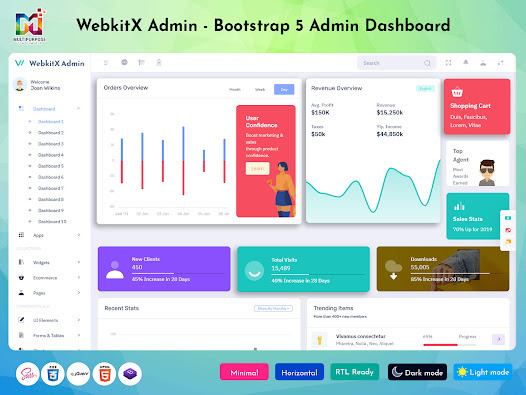
Bootstrap Admin Template have become an integral part of web applications and websites. Whether for managing content, monitoring performance, or tracking business metrics, admin templates provide an organized way to interact with complex data. One of the most popular frameworks for developing admin dashboards is Bootstrap, an open-source front-end framework. Its flexibility, scalability, and ease of use have made it a go-to choice for developers.
Our Bootstrap Admin Template comes with a powerful set of features, including seven analytics dashboards and three CRM dashboards, all built with the latest Bootstrap 5 framework. In this article, we will delve into the importance of Bootstrap admin templates, explore the benefits of our master dashboard, discuss the web development process with our Bootstrap admin template, and explain why we stand out in the competitive market.
1. Importance of Bootstrap Admin Template
Admin templates serve as the backbone of modern web applications, providing users with a structured and functional interface to interact with data. In any web application, especially those dealing with large amounts of information or business operations, managing the backend is just as crucial as the frontend. Here's why a Bootstrap Admin Template is important:
a. Consistency and Efficiency
Bootstrap provides a consistent design system that ensures your Master Dashboard looks polished and professional across all devices. The admin template built on Bootstrap follows this system, which results in a responsive layout, intuitive user interface, and easy-to-use components. By leveraging Bootstrap, you avoid having to create these elements from scratch.
b. Time-Saving
For web developers, time is a precious resource. A pre-built Bootstrap Admin Template like ours saves a significant amount of time during the development process. Instead of building every feature from the ground up, developers can use the template’s pre-built features, like navigation menus, charts, and tables, which speeds up development without compromising on quality.
c. Mobile Responsiveness
In today’s mobile-first world, ensuring that your admin panel works flawlessly on mobile devices is crucial. Bootstrap’s grid system allows developers to create responsive layouts with minimal effort, ensuring your dashboard will look great on screens of all sizes—whether it’s a desktop, tablet, or smartphone.
d. Customization Flexibility
While WebApp Template come with a set of predefined elements, they also offer ample room for customization. Developers can easily modify or extend the templates to meet the specific needs of their project. From changing the color scheme to adding new widgets, Bootstrap admin templates allow easy modification to align with the brand’s identity.
e. Built-In Components and Widgets
Bootstrap is known for its comprehensive library of UI components. From buttons and cards to forms and modals, everything you need to create an admin dashboard is available. Bootstrap 5 offers enhanced features like improved grid layouts, native custom form controls, and additional utilities, all of which help in developing complex admin dashboards.
2. Benefits of Our Master Dashboard
Our Master Dashboard, built with the latest Bootstrap 5 framework, offers a comprehensive solution for managing and monitoring all aspects of your application or business. It is packed with features to ensure an efficient and productive experience for both administrators and end-users. Here are some of the key benefits:
a. Comprehensive Analytics Dashboards
Our dashboard offers seven analytics UI Dashboard, each tailored for specific use cases. Whether you’re tracking user engagement, sales data, traffic patterns, or marketing performance, these dashboards are designed to give you valuable insights at a glance.
Real-Time Data: The analytics dashboards provide real-time data, allowing you to make informed decisions quickly.
Advanced Charts and Graphs: With rich charts, graphs, and tables, the dashboard transforms raw data into digestible, visual representations.
Customizable Widgets: You can add, remove, or customize widgets to suit your specific needs.
b. CRM Dashboards for Customer Relationship Management
Our three CRM dashboards are designed to help businesses track and improve their customer relationships. The dashboards offer valuable insights that assist in managing leads, tracking sales pipelines, and improving customer satisfaction.
Lead Management: Easily track the status of leads and opportunities with detailed reports and timelines.
Customer Interactions: Monitor customer interactions, allowing your team to provide more personalized service.
Task and Activity Tracking: Keep an eye on sales activities, ensuring that important tasks are completed on time.
c. User-Friendly Interface
One of the core principles of our Dashboard UI is its user-friendly interface. Thanks to Bootstrap 5’s sleek and intuitive design, the dashboard is easy to navigate, even for non-technical users. The layout is structured logically, allowing users to access the information they need without confusion.
d. Customization and Scalability
Our Master Dashboard is not just functional but also highly customizable. You can change the design, add new features, or tweak existing ones to better fit your business requirements. Whether you need to add a new widget or adjust the layout for specific devices, the template allows easy modifications. Plus, the modular structure of the dashboard makes it scalable, meaning it can grow as your business or application does.
e. Optimized Performance
Our Admin Dashboard UI is optimized for performance. It’s lightweight, ensuring fast loading times, even when dealing with large datasets. Bootstrap’s modular design helps ensure that only necessary resources are loaded, keeping the page load time to a minimum.
3. Web Development Process with Our Bootstrap Admin Template
The web development process can be complex, especially when building an admin dashboard that requires features like analytics, CRM tools, and real-time data tracking. Our Bootstrap Admin Template simplifies this process and makes it more efficient.
a. Step 1: Planning and Requirement Gathering
The first step is to clearly define the project’s goals and understand the requirements. This involves determining the key metrics you want to track, understanding user roles (admin, manager, user), and identifying the features you need, such as the analytics dashboards, CRM tools, or data visualizations.
b. Step 2: Designing the User Interface
Once the requirements are set, the next step is designing the user interface. The UI design ensures the user experience (UX) is smooth and intuitive. Thanks to Bootstrap 5, developers have access to a modern, responsive grid system that adapts to any device, ensuring a seamless experience across desktops, tablets, and smartphones.
Our template provides pre-designed pages, including dashboards, login screens, and user management, allowing you to build a professional-looking admin panel without the hassle of custom design.
c. Step 3: Setting Up the Template
After the design phase, the next step is integrating the Bootstrap Admin Template into the project. This is where the real development begins. You can begin customizing the provided template, adding your desired components, and incorporating data into the analytics and CRM dashboards.
Our Admin Dashboard UI includes built-in components like charts, tables, forms, and modals, which can be configured to fetch data dynamically and be used in the backend of your web application. The template also includes pre-configured JavaScript and jQuery components for handling events and interactions.
d. Step 4: Data Integration
Once the design and layout are ready, the next step is integrating the data. Whether you are pulling data from a database or external API, you can configure the dashboard to fetch and display data dynamically. The analytics and CRM dashboards will be connected to your backend systems, allowing the data to update in real-time.
e. Step 5: Testing and Optimization
Testing is a critical part of the development process. Our Bootstrap Admin Template is built with cross-browser compatibility in mind, so it works seamlessly on different browsers (Chrome, Firefox, Safari, etc.). You can test the template on various screen sizes and devices to ensure its responsiveness.
Performance testing is another crucial aspect. The template is optimized to handle large datasets without compromising speed or performance. Developers can use tools like Google Page Speed Insights or Lighthouse to test and improve performance.
f. Step 6: Deployment and Maintenance
Once everything is in place and tested, it’s time to deploy the application to a live environment. Our Bootstrap Admin Template ensures that deployment is smooth, whether you’re using shared hosting, VPS, or cloud services. Post-launch, you can continue to make updates and improvements as needed, thanks to the template’s scalability.
4. Why We Are Better?
In a competitive market filled with various Bootstrap admin templates, what makes our Bootstrap Admin Panel stand out? Here are a few reasons why we are the best choice for your project:
a. Built with Latest Bootstrap 5
We’ve used the latest version of Bootstrap (Bootstrap 5), which comes with new features like custom form controls, enhanced grid systems, and improved utilities. This ensures the template is future-proof and delivers an outstanding user experience.
b. Fully Responsive and Customizable
Our Dashboard Template is fully responsive and adaptable to any screen size, providing a seamless experience on desktop, tablet, and mobile devices. Plus, it’s highly customizable, allowing you to tailor it to your specific business needs.
c. Pre-Built Dashboards
We’ve included seven powerful analytics dashboards and three CRM dashboards, offering a comprehensive suite of tools to help businesses track performance and customer data effectively. The dashboards are easy to use and packed with features to boost productivity.
d. Optimized for Performance
Our Bootstrap Admin Theme is optimized for high performance, ensuring quick load times even with large datasets. This makes it suitable for high-traffic web applications and enterprise solutions.
e. Detailed Documentation and Support
We provide detailed documentation, ensuring that developers can easily understand how to use and customize the template. Plus, our dedicated support team is always ready to assist you with any questions or issues you may have.
5. Contact Us
If you are looking for a high-quality Bootstrap Admin Template to power your web application, look no further. Our master dashboard comes packed with all the features you need, from analytics tools to CRM dashboards, all built on the latest Bootstrap 5 framework.
#admin dashboard ui#Bootstrap Admin Panel#Dashboard UI#Bootstrap Admin Template#UI Dashboard#Master Dashboard
0 notes